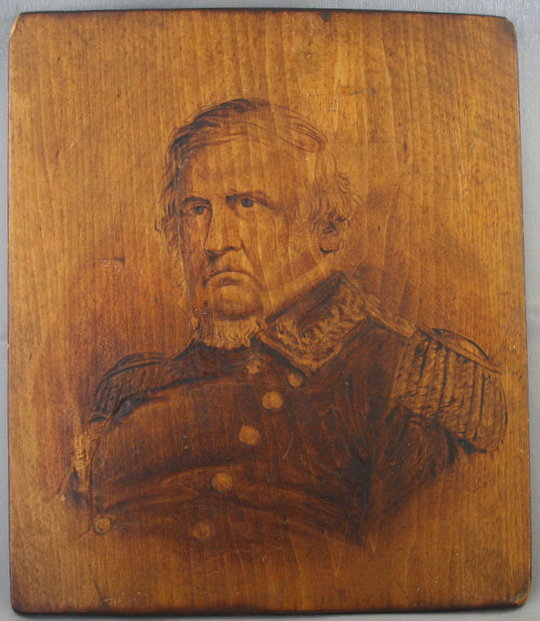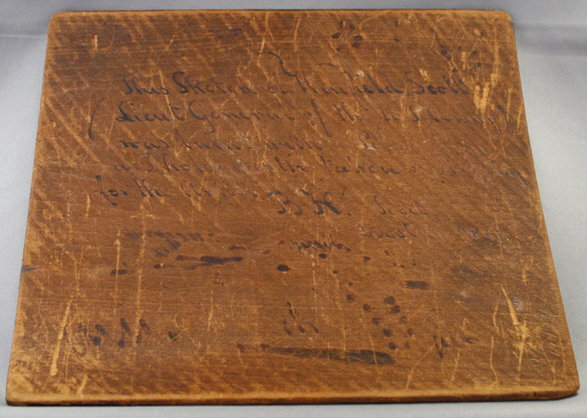E-Museum of Pyrographic ArtAntique Art Hall
|
| - Café Flambé - | - Portraits and Paintings - | - Decorative and Applied Art - |
| - Folk and Traditional Art - | - Antique Art - | - Special Hall - | - Sculpture - |
| - Children's Hall - | - Bookstore and Library - | - Tools and Techniques - |
 |
| Lieut. General Winfield Scott By Ball Hughes, Boston, 1861 Poker work on an unframed wood panel, approx. 8.5 in. wide by 10 in. tall After a photograph "taken expressly for the artist" |
 |
| Lieut. General Winfield Scott, detail verso By Ball Hughes, Boston, 1861 Inscription on the back reads: This Sketch of Winfield Scott N.B. The Latin word fecit following the artist's initials means he made it and was a convention of that time. It was used then the way today he might have written made by B. H. |
The above initialed and dated bust is an 1861 poker art portrait of U.S. Civil War officer and strategist Gen. Winfield Scott (1786–1866). It is a work by Robert Ball Hughes, the famous 19th century pyrographer, engraver and sculptor. The link on Gen. Scott's name here is to a short and most interesting biographical sketch of his career. Salient in that account is the fact that he was a native Virginian, who unlike Gen. Lee, served in the Union Army and lived to see the war end, his strategy for it vindicated, and the Union preserved.
This burnt wood panel has historical significance both as a reflection of its time and for the artist. A significant coincidence is that the year Gen. Winfield Scott resigned (1861) was the year Ball Hughes did his pyrographic portrait. Gen. Scott's command was passed immediately to Gen. George McClellan, whose portrait Ball Hughes rendered the following year, so the sequence of the two portraits reflects the sequence of historical events. It is also worthy of note that Ball Hughes did pyrographic portraits of five generals/presidents: Gen. Winfield Scott (1861), Gen. McClellan (1862), Gen. Grant (1865, before his becoming president), Gen. John Fremont (cited but not yet found), and Gen. & Pres. George Washington. It is also known that Ball Hughes did a sculpture—a portrait bust—of Andrew Jackson shortly after he became president.
The artist Robert Ball Hughes was born January 19, 1804, in London, England, U.K., and died March 5, 1868, in Dorchester, Massachusetts, U.S.A. Ball Hughes is how he usually signed his name on most of his poker works, i.e., without his first name Robert. However, instead of signing Ball Hughes on the verso (back) of the Gen. Scott panel, the artist signed with only his initials, even though he wrote an elaborate inscription there. There are other examples of Ball Hughes' works where he signed with only his initials B. H. but it is not known why.
The existence of this panel was unknown to the E-Museum before its appearance in 2009 at auction on ebay.
If you have any questions or any additional information to offer about this panel of Gen. Winfield Scott, or other pyrographic works by Ball Hughes, please e-mail the E-Museum Curator.
You are leaving the Ball Hughes Salon No. 21.
You can return to the
Antique Hall
or visit one of the following:
Pyrographic Art Exhibit Halls:
Portraits and Paintings
Decorative and Applied Art
Sculpture
Traditional and Folk Art
Children's Pyrographic Art
Special Pyrographic Art
The Book Store and E-Museum Library
Pyrography Tools and Techniques
Your questions and comments are welcome and appreciated.
Please e-mail the E-Museum Curator
Back to E-Museum Entrance homepage
© 2009 Kathleen M. Garvey Menéndez, all rights reserved.
8 November 2009.

